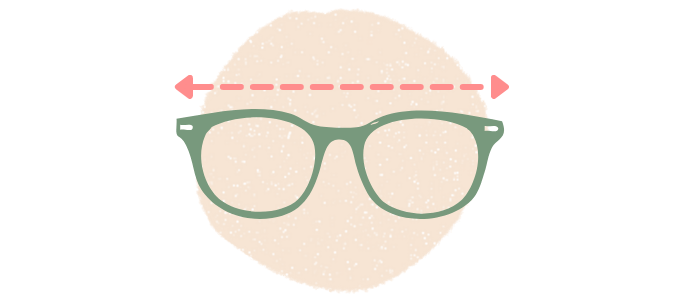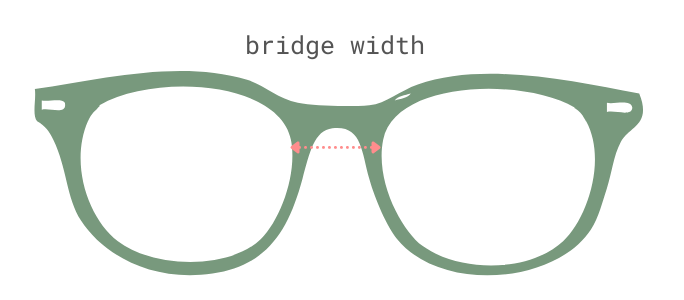A perfectly-fitting pair of glasses can work wonders. On the flip side, a pair that fits poorly can look strange and be uncomfortable to wear.
The secret to buying a pair of glasses online that you truly love? Know your frame size!
This guide will show you how to quickly and accurately get your own glasses measurements. We’ve also thrown in some helpful tips that will help you find the most precise and flattering fit.
Once you’ve worked out your ideal glasses measurements, you’ll be free to browse our Mouqy collection and find your perfect pair!
First things first: Understand your glasses
When checking your measurements for a new pair of eyeglasses, it’s helpful to understand the different working parts.
Here’s a quick shorthand of the common terms you’ll see. They’re all typically measured in millimeters (mm).
- Frame widthThe horizontal length of your frames, including any design elements that stick out.
- Temple lengthAlso known as ‘arm length’, this refers to the length of each arm from the hinge to the tip, including the bendy bit that sits behind your ears.
- Lens heightThe tallest point of your lenses within the frame.
- Lens widthThe widest horizontal length of each lens.
- Bridge widthThe length of the part of your eyeglass that sits on your nose.
Finding your own glasses measurements is very simple, especially if you already have a pair of specs lying around.
Here are the 3 easiest methods:
Getting your frame measurements
1. How to read your measurements off old glasses
The easiest way to know your size is to start with a pair you already own. Just be sure to check they still fit well on your face!
Look inside the temple of your old glasses (typically referred to as the “arm”), and you’ll usually find 3 sets of numbers printed there.
The measurements should always appear in this order:
- Lens width
- Bridge width
- Temple length
For example, if your glasses said ‘52-16-135’…
- The first number, 52, refers to a lens width of 52mm;
- The second number, 16, is to bridge width of 16mm;
- The last number, 135, refers to temple length of 135mm.
Sometimes, you’ll also find a 4th number printed on the temple arms that usually refers to your lens height. Some glasses may also include extra numbers, letters and names that refer to the frame model or color. If in doubt, it’s best to grab a ruler and follow the steps in the next section to double check the numbers.
However, there’s an important measurement that won’t be written on your glasses, but that you’ll definitely need to know when buying glasses online: frame width. To measure frame width, just grab a millimeter ruler and measure the horizontal frame span from one end to the other (check out the diagram in the section below).
2. How to measure a pair of old glasses
In case your existing glasses don’t have the measurements printed on them, you can easily measure it yourself at home. All you need is a millimeter ruler.
1. Measuring the frame width
How: Measure the entire span of the frame from one end to the other. Make sure to include any hinge or design pieces that stick out
Typical measurements: >129 mm for small or narrow faces, <139mm for wider faces.
2. Measuring the lens height
How: Measure the lens from the bottom to the very top.
Typical measurements: >30mm.
3. Measuring the lens width
How: Measure each lens from left to right at the point where it is widest. Ensure that the lens is in line with your pupillary distance so that it is aligned with the center of the lenses.
Typical measurements: 31mm to 60mm.
4. Measuring the bridge width
How: Measure the space between the inner edge of one lens to the other, horizontally (take care you’re not just measuring from the edge of the frames).
Typical measurements: 12mm to 31mm.
5. Measuring the temple arm length
How: Measure the entire span of the temple arms, starting from the hinge right to the end where the arm starts to bend. Then, measure the bit where the beginning of the arm starts to bend, to the end. Add the numbers together and you’ll get your temple arm length.
Typical measurements: 135mm, 140mm, 145mm, and 150mm.
3. How to get your measurements if you don’t have glasses
If you don’t already have an existing pair of glasses, don’t worry! You can still measure your face for glasses with a couple of tools:
- A millimeter ruler
- A mirror
Check out this video below to see how:
Some helpful tips for getting the right fit
1. Getting the frame width right
Frame width is one of the most important measurements to get right when buying new glasses. Pick a frame that is too narrow and your face can look too wide. Pick one that’s too wide, and your face will look too thin!
The trick is to look for a frame that’s about a finger’s width wide between the arm and your face and no wider. As a rule, your eyes should sit nearly centered within the width of your lenses.
2. Understanding temple length
Ill-fitting arms or temples will result in glasses that are either too loose, or too tight. The eyeglass temple should fit just right along your face, and sit comfortably on top of your ear.
3. Getting the best lens height & lens width
The right lens height and width can really enhance your eyes. Frames that have the lens set too wide will result in eyes that look too close together, while narrow set lenses can make your eyes look uncannily wide.
Select frames with the correct lens height and width by ensuring that your eyes are centered within the lenses.
4. Finding the ideal bridge width
You’ll want to make sure that the bridge sits comfortably against your nose. However, you should take into account your own facial structure. For example, low bridges are more common in certain groups of people, including those of Asian descent.
In addition, the closer your eyes are set, the narrower the bridge width should be.
- If you have a narrow nose bridge or your eyes are close-set, you might want a smaller bridge width (15mm to 18mm).
- If you have a wider nose bridge or wide-set eyes, you might want a larger bridge width (18mm to 22mm).
When shopping for new glasses, take a look at the frame design and see where the bridge is located in relation to the brow line.
- If you have a higher nose bridge (above your pupils) select a frame where the bridge is nicely in line with, or close to, the frame’s brow line.
- If you have a lower nose bridge (below your pupils), try to pick frames with a bridge that falls below the brow line, or with a curved brow line.
Lastly, bear in mind that frame thickness can also affect your bridge measurement. Since bridge width is measured from the inside of the frame, a thin-rimmed frame and a thick-rimmer frame with the same bridge width measurement can actually fit quite differently on your face.
How to use your measurements to buy eyeglasses online
Buying glasses online is a lot like online clothes shopping – impossible if you don’t know your size! Once you have your own personal glasses measurements, you can easily refer to them when browsing eyewear shops like Mouqy.
As a general rule, you can allow a leeway of 2-3 mm on each measurement except for the bridge width. For the bridge measurement, you should allow a leeway of just 2mm to ensure the most comfortable fit!
Measurements done? Happy browsing!
With your newfound knowledge, you now have all the information you need to start shopping for a brand new pair of eyeglasses.
In addition to measuring your eyeglasses, you can always check out our Mouqy Virtual Try-On to help you find yourself a frame that best flatters your face!



















